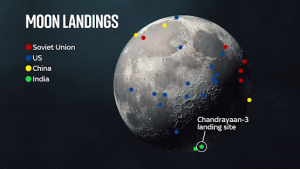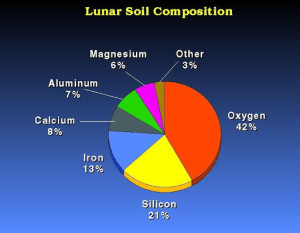In the canvas of the cosmos, a celestial dance unfolds, and amidst this cosmic ballet, our very own moon gleams like a radiant partner. Humanity’s fascination with Earth’s faithful companion has propelled us to new heights, both literally and metaphorically. On August 23, 2023, a momentous chapter was added to this saga as India’s Chandrayaan-3 touched down gracefully at the moon’s uncharted south pole. This achievement resonates not just in the realm of science but in the hearts of dreamers worldwide.

The Mystique of the South Pole: Unveiling Lunar Secrets

The south pole of the moon is a treasure mine of potential, shrouded in gloom and mystery. Scientists have long suspected that this polar area contains water ice, which might be a significant changer for humanity’s cosmic voyage. Water, the elixir of life, has the potential to catalyze the realization of sustainable lunar exploration by powering our rockets, quenching astronaut thirst, and nourishing the seeds of our ambition.
Chandrayaan-3: A Mobile Laboratory of Discovery
At the core of this rare undertaking is Chandrayaan-3, a mobile scientific laboratory filled with cutting-edge instrumentation. These technological wonders are more than simply tools; they are portals to the moon’s ancient history and untapped possibilities.

The Chronicles of Lunar History
The equipment aboard Chandrayaan-3 will dissect the composition of the lunar landscape with laser-like accuracy. Rocks and soil samples will provide information on volcanic eruptions, cosmic collisions, and the ages that sculpted the moon into the fascinating spherical we know today.

Quest for the Ice: Humanity’s Lunar Sustenance

The primary objective is to uncover the mystery of water ice. Chandrayaan-3’s carefully calibrated sensors set out on a cosmic treasure hunt under the lunar surface. The discovery of water ice not only rewrites lunar history but also maps a new path for humanity’s cosmic ambitions, repositioning the moon as a possible rest stop on humanity’s trip to the stars.
The Silent Sentinel: Radiation Guardianship
Beyond its calm exterior, the moon’s surface is riddled with radiation risks that future lunar explorers must manage. The suite of equipment on Chandrayaan-3 includes radiation sensors, which will measure the lunar radiation environment, assisting in the safe planning of future missions and safeguarding the well-being of adventurous explorers.
Invisible Architects: Moon’s Gravity and Its Stories
Gravitational forces on the moon have molded its topography, leaving behind a patchwork of craters and peaks. The trip of Chandrayaan-3 involves a meeting with these unseen architects, who will untangle the delicate dance between gravity and lunar materials, providing insight into the moon’s genesis, evolution, and destiny.
A Global Overture: United in Cosmic Curiosity
Chandrayaan-3 is more than an Indian achievement it is a worldwide appeal to international partnership. Borders fade and knowledge unifies throughout the universe. Chandrayaan-3 advocates for a harmonic symphony of cosmic exploration, transcending nations and promoting an attitude of shared knowledge through sharing data and findings.
A Trailblazer’s Legacy: India’s Triumph at the Moon
Given the recent loss of Russia’s Luna 25 mission, the Chandrayaan-3 mission’s successful landing is even more crucial. Luna 25 also made an effort to touch down on the Moon’s south pole, but it crashed during its descent. The failure of Luna 25 illustrates the difficulties in landing on the Moon and thus makes Chandrayaan-3’s successful landing all the more remarkable.

The failure of Luna 25 also highlights the importance of Chandrayaan-3. Currently, Chandrayaan-3 is the only mission to have made a successful landing at the Moon’s south pole. India now has a massive advantage in the race to explore this part of the Moon.
A Prelude to Cosmic Odyssey
First images of Chandrayaan-3’s Vikram Lander’s rover rolling out on the surface of the moon. Photo: Special Arrangement
The significance of Chandrayaan-3 grows as time goes by and the spacecraft continues to travel around the moon. It turns into a sentinel of discovery in the void of space, serving as a light lighting the routes of upcoming lunar missions. This journey, however, transcends the boundaries of science; it appeals to dreamers and piques the interest of both young and old people alike.
The victorious landing of Chandrayaan-3 in the south pole of the moon is not the end, but rather the beginning of mankind’s cosmic voyage. The new questions, mysteries, and aspirations that are waiting to be revealed are hinted at by its instruments. The cosmos is a symphony of untold tales, and we, as cosmic travelers, are ready to set off on a voyage that will be driven by curiosity, nourished by knowledge, and directed by the stars. This compels us to look up at the night sky with renewed awe.



